NEC PA271W - When Accuracy and Consistency Matter
by Chris Heinonen on May 1, 2012 1:55 PM ESTNEC PA271W - Display Uniformity
As we’ve mentioned, NEC goes to great lengths with their PA271W display to make it as uniform as possible. With the sacrifices in maximum light output we hope that we will see a measurable difference on the NEC in both brightness and color uniformity.
The brightness uniformity chart shows results that are far and away the best I have measured to date. The total deviation from the maximum to the minimum value is only 10 nits, and we are used to seeing a swing of 30 or even more nits on this test. The average deviation is only 1.66%, so this is a really fantastic result showing that NEC has managed to engineer a more uniformly bright panel than anyone else.
Measuring the black uniformity is harder, as we have no 200 nits target that the white uniformity has. In this case we wind up with an average black level of 0.35 nits, but a higher standard deviation of 18.7%. The issues fall in the upper-right area of the screen which also had the brightest areas in the white uniformity testing, so there might be a little more light leakage coming in from that area of the panel it seems. Note that this non-uniformity will likely vary by panel as well. Given that the panel is uniformly lit, and that affects the color accuracy to a great deal, I would expect the panel to have a fairly consistent dE across the display.
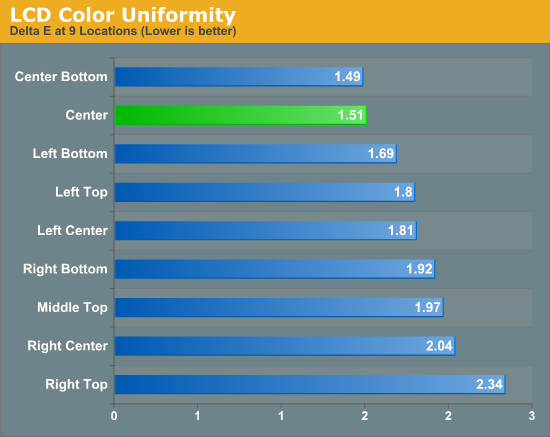
The NEC delivers here again. We wind up with average and median dE values of 1.84 and 1.81, and a standard deviation of only 0.27 dE. The upper right corner seems to have a bit of an issue again, likely due to that lighting uniformity issue, but the rest of the panel is remarkably close together. The colors are all uniform in error across the screen and the issue seems to be a slight rise in grayscale error as you move away from the center. Compared to any other panel I have reviewed, the NEC is far more uniform and will exhibit less of a color shift across the unit, which is important on a screen this size. It still isn’t perfect by any means, but it’s better than anything else I have tested.
I also realized with this review that the vertical axis here was shifting between each review, so I’m going to keep this at 8 for this review, and then see going forward if that is correct. This will make it easier to compare across different displays.


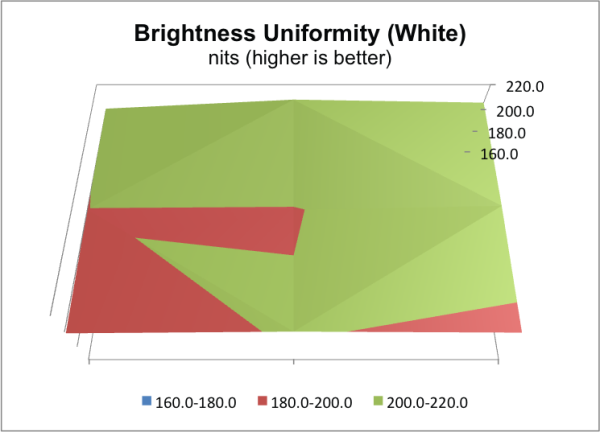
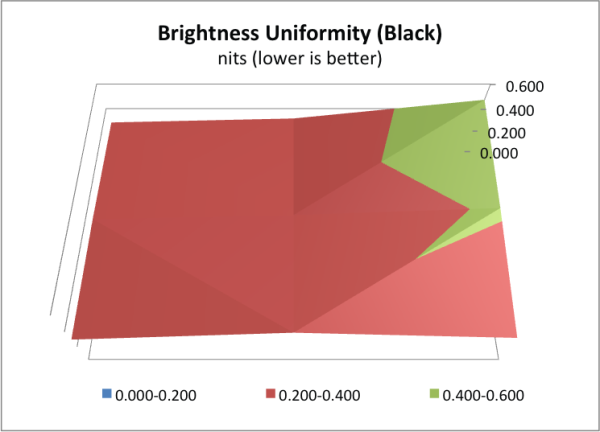
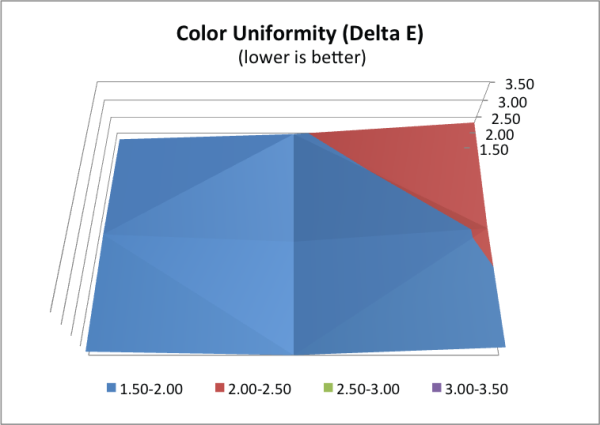
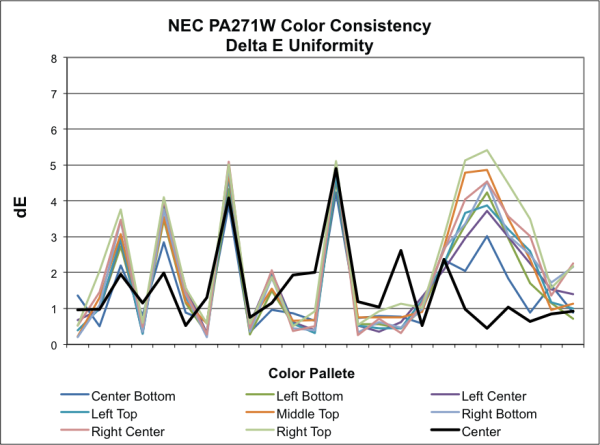








69 Comments
View All Comments
Oxford Guy - Wednesday, May 2, 2012 - link
I have three bones to pick:1. The sRGB color space is important, more important than AdobeRGB for most users, and yet Anandtech's monitor reviews always fail to provide information about sRGB coverage and use AdobeRGB as the baseline for comparison.
2. The chart heading calling monitor gamut "color quality" is misleading, especially when dealing with wide-gamut monitors that have non-functioning sRGB modes -- leading to overly saturated color when viewing sRGB content. For many users, such a monitor would be considered to have inferior color "quality". Also, for sRGB content, a standard gamut monitor with good uniformity and good black level would have good "color quality" when used with sRGB content—potentially better than a wide-gamut monitor with poor black level. Change it to "color range", "gamut", or something else that doesn't give the impression that the colors the monitor is capable of representing are somehow better simply because there are more of them.
3. There is still no mention of PWM flicker in the article, or whether or not this model uses PWM or constant control.
Oxford Guy - Wednesday, May 2, 2012 - link
The other problem with "color quality" as a heading is that it doesn't reflect banding, noise, and other issues related to FRC dithering, the lack of a hardware LUT, broken hardware firmware (as was documented in the Dell U2410 by prad.de -- user mode wasn't working properly), and such.bjnicholls - Wednesday, November 28, 2012 - link
sRGB is a small subset of ARGB. Any wide gamut display used with proper color managed workflow can accurately display the thin, weak color gruel that is sRGB.sRGB is the "least common denominator" color space and the only thing important about it is knowing how to deliver images optimized for sRGB with as few negative effects as possible.
beebbeeb - Wednesday, May 2, 2012 - link
A review of any "professional" grade monitor would not be complete without benching it against the gold standard : Eizo. On reviewing Anandtech archive the last review of an Eizo was in 2006, a shootout involving Eizo L997, which duly came out as the champ. On the strength of that review, I bought one for nearly US$2,000 in 2006, used for viewing CAD drawings. Look forward to a "hottubbing" of the NEC, Eizo and other professional monitors.appliance5000 - Wednesday, January 2, 2013 - link
I think NEC is as much a gold standard as Eizo - has that ever been a question.UrQuan3 - Thursday, May 3, 2012 - link
You know, the funny thing is I *HATE* dimming backlights. It's like a car that adjusts the volume based on how fast you're going. I'm sure it makes benchmarks give better numbers, but it's really unplesant to use.The backlight on my laptop changes based on how much white there is on the screen. The effect is that everytime I open a menu, all the colors on the screen change. It's implemented in the Sandybridge drivers and cannot be turned off. The only way to prevent it is to run the screen at full brightness. That seems to disable the dimming.
seapeople - Saturday, May 5, 2012 - link
FWIW, I hate it when cars DON'T have auto volume based on the speed you're going. What sounds appropriate at 70 on the highway is absolutely blasting when you come to a stop. Don't understand what you'd have against it.bobbozzo - Monday, May 7, 2012 - link
Yeah, the 'dynamic contrast' on my Samsung 2343BWX is unbearable for PC work. Fortunately it is easy to turn off.mtfreitasf - Thursday, May 3, 2012 - link
I have been following your monitor reviews for a while but have never heard about Eizo which has a name in the pro market. Is there an explanation for this omission? Yours.